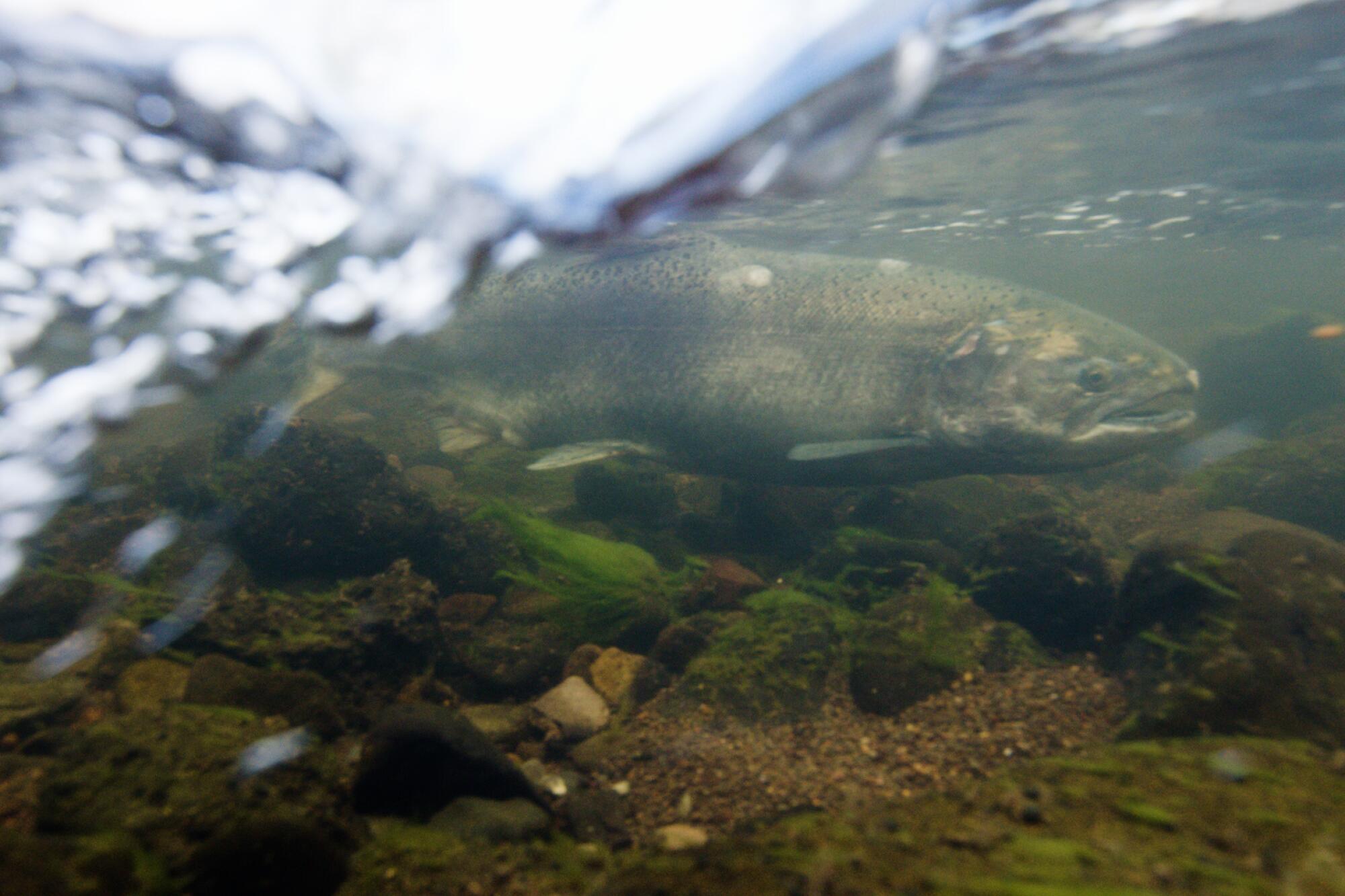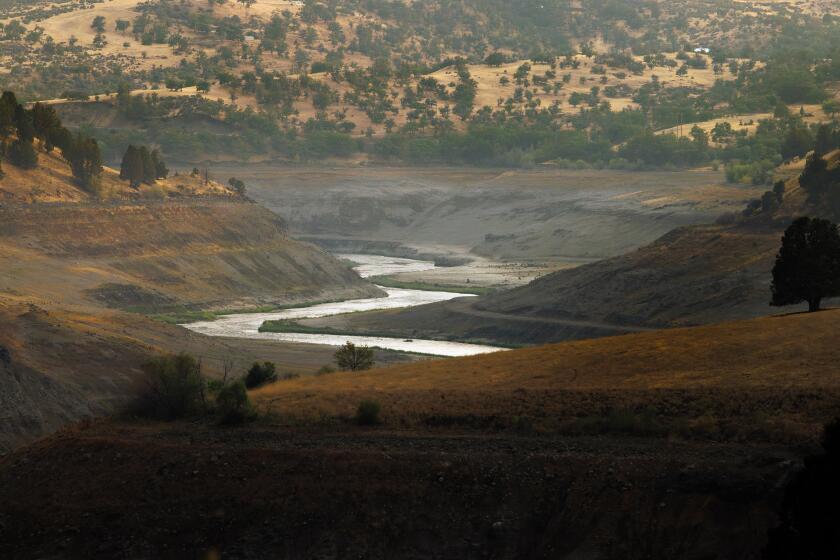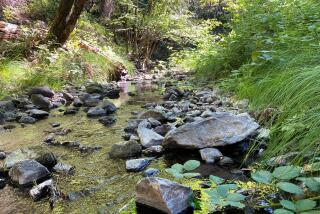
- Share via
Less than two months after the removal of dams restored a free-flowing Klamath River, salmon have made their way upstream to begin spawning and have been spotted in Oregon for the first time in more than a century.
Biologists with the Oregon Department of Fish and Wildlife announced that they found a single fall-run Chinook on Oct. 16 in a tributary of the Klamath River upstream of the spot where J.C. Boyle Dam was recently dismantled.
State biologists in California have also been seeing salmon in creeks that had been inaccessible since dams were built decades ago and blocked fish from reaching their spawning areas.
“It’s amazing,” said Ron Reed, a Karuk Tribe member and traditional fisherman. “That’s what we’ve prayed for.”
The largest dam removal project in U.S. history has freed the Klamath River, inspiring hope among Indigenous activists who pushed for rewilding to help save salmon.
Reed and other Indigenous leaders and activists spent decades campaigning for the dams to be removed, believing that restoring the river would help struggling salmon populations recover. Reed said he isn’t surprised the fish have quickly made their way far upriver and into their ancestral creeks.
“They’re very adept and very resilient,” Reed said. “And the fact that the fish are going up above the dams now, to the most prolific spawning and rearing habitat in North America, it definitely shines a very bright light on the future. Because with those dams in place, we were looking at extinction. We were looking at dead fish.”
The hydroelectric dams, which were built between 1912 and the 1960s, not only blocked salmon from reaching spawning areas but also degraded the river’s water quality, contributing to toxic algae blooms and disease outbreaks that at times killed masses of fish. With those dams now gone, members of Native tribes along the river say they are optimistic that salmon, which are central to their cultures and fishing traditions, will thrive again.
The dismantling of four dams took more than a year and was the largest dam removal effort in U.S. history. The utility PacifiCorp agreed to take down the aging dams — which were used for power generation, not water storage — after determining it would be less expensive than bringing them up to current environmental standards.
The $500-million project’s budget included funds from California and from surcharges paid by PacifiCorp customers.
In late August, workers using machinery carved channels in the remnants of two dams, allowing water to flow freely again along more than 40 miles of the Klamath River.
Salmon now have access to more than 400 miles of the river and its tributaries, and can reach cold spring-fed waters that have been inaccessible for generations.
Reed and other members of the Karuk Tribe have been fishing for fall-run Chinook. He said the fish they are catching in their nets look strong and healthy — “so much more beautiful this year.”
He said he feels confident that dam removal, along with other efforts, will revitalize the fish populations. Many people in Karuk communities, he said, are feeling hope and excitement — a “magnetic vibration.”
“The health and wellness of our people in the communities are so dependent upon the fish,” Reed said. “This really brings positive energy and hope for the future.”
Biologists from the California Department of Fish and Wildlife have spotted fall-run Chinook salmon in tributaries miles upstream from where Iron Gate Dam was removed.
“It’s all very exciting. We’ve been seeing them successfully spawning,” said Morgan Knechtle, a senior environmental scientist with the department who has been participating in the surveys.
“They’re doing what we had hoped,” Knechtle said. “It looks like fish are adapting well and doing just what they’ve been doing for many, many thousands of years.”
The recently completed removal of dams on the Klamath River is raising hopes of rebuilding the population of threatened spring-run Chinook salmon.
The salmon are just starting to spawn, and biologists plan to continue surveys to track how many fish spawn and die along the Klamath during the next couple of months.
Fish are also being tracked in other ways. Earlier this month, scientists with the nonprofit group California Trout announced they had captured images of the first Chinook salmon swimming upstream from where Iron Gate Dam once stood. The group is working together with tribes and state and federal agencies on a monitoring program, and scientists are using a newly installed sonar station to record images of passing fish.
The California Department of Fish and Wildlife’s plan for reestablishing wild, self-sustaining salmon populations in the Klamath calls for monitoring Chinook and coho salmon, as well as steelhead and lampreys, as fish gradually move into areas upriver over three or four generations during the next 12 to 15 years.
In Oregon, when a survey team first spotted a large fish rise to the surface, they saw only its dorsal fin, said Mark Hereford, Klamath fisheries reintroduction project leader for the Oregon Department of Fish and Wildlife. “I thought, was that a salmon or maybe it was a very large rainbow trout?”
When the team returned, they confirmed the fish was a Chinook salmon.
Leaders of the Klamath Tribes in Oregon said they are overjoyed about the arrival of the salmon. They consider the fish relatives and call them c’iyaal’s.
“This is what our members worked for and believed in for so many decades,” said Roberta Frost, secretary of the Klamath Tribal Council.
The nonprofit Klamath River Renewal Corp. announced the completion of all dam removal work on Oct. 2. Two other dams, which aren’t affected by the project, remain farther upstream in Oregon.
Other efforts to restore the watershed to a more natural state will continue for several years. As part of the restoration efforts, members of the Yurok Tribe have been scattering seeds of native plants to restore vegetation on 2,200 acres of reservoir bottomlands that were exposed when the dammed areas were drained.
“The river takes care of us, and we take care of the river,” said Joseph L. James, chairman of the Yurok Tribe.
Seeing the salmon quickly reappear in the river, he said, is a historic moment that holds great meaning for the Yurok people.
“Our salmon have returned home,” he said. “It’s a beautiful thing.”









